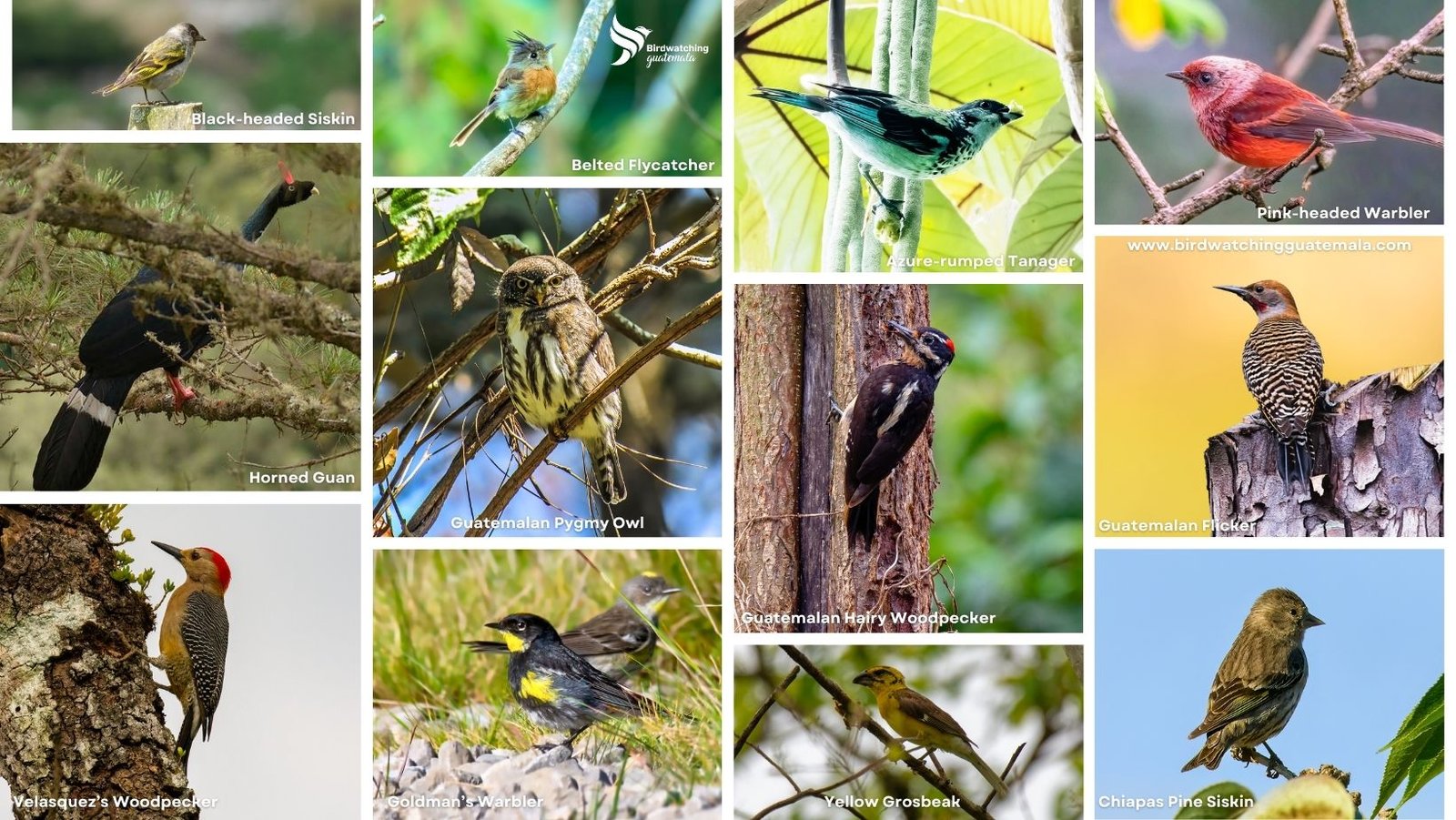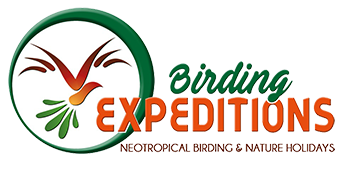
Unveiling Guatemala’s Birdlife in Endemic Regional Areas
Guatemala, located at the northern edge of Central America, is a jewel of biodiversity and a premier birding destination. With more than 766 bird species across 83 families and 427 genera, the country’s varied landscapes—from misty highlands to tropical rainforests—offer habitats for both rare endemic birds and spectacular migratory visitors.
Nestled within the Mesoamerican Biological Corridor, Guatemala’s compact geography contains a remarkable range of ecosystems. This allows birdwatchers to encounter a vibrant spectrum of species within relatively short travel distances, making it one of the most rewarding birding destinations in the world.

Talk To A Travel Advisor
GT: (502) 7832 2742
US: (305) 395 3935
Guatemala’s Avian Diversity at a Glance
Total species: 766+ recorded
Endemic to Guatemala & nearby regions: 35+ species
Habitats: Highlands, tropical savannas, Caribbean rainforests, Pacific wetlands, dry valleys, and the Petén jungles
National Bird: The Resplendent Quetzal (Pharomachrus mocinno), a symbol of freedom and beauty
From jewel-toned hummingbirds to powerful raptors, the Birds of Guatemala represent a rich blend of color, song, and ecological adaptation.
Endemic Regional Areas and Key Bird Habitats
Guatemala’s birdlife is concentrated in several Endemic Bird Areas (EBAs) recognized by ornithologists for their unique species. These EBAs overlap with five major habitat types:
1. Highlands of Northern Central America
Covering parts of Guatemala, Mexico (Oaxaca & Chiapas), Honduras, El Salvador, and Nicaragua, the highlands host rare species such as:
Horned Guan (Oreophasis derbianus)
Pink-headed Warbler (Ergaticus versicolor)
Cabanis’ Tanager (Tangara larvata)
Cool cloud forests and pine-oak woodlands here create microhabitats where these species thrive.
2. Tropical Savannas of the Northern Pacific Slope
Stretching along Guatemala’s Pacific coast and into neighboring countries, these lowland areas are home to:
Yellow-naped Parrot (Amazona auropalliata)
Pacific Parakeet (Psittacara strenuus)
White-throated Magpie-jay (Calocitta formosa)
The mixture of open savannas and scattered woodlands makes this region especially rich in parrot and jay species.
3. Tropical Rainforest on the Caribbean Slope
Located mainly in Izabal (northwestern Guatemala), these lush forests are alive with:
Wedged-tailed Sabrewing (Campylopterus curvipennis)
Keel-billed Motmot (Electron carinatum)
Gray-headed Piprites (Piprites griseiceps)
This habitat boasts over 500 bird species, thanks to its dense vegetation and year-round humidity.
4. Lowlands of the Yucatán Peninsula
Extending into northern Petén and Belize, these forests and scrublands harbor:
Ocellated Turkey (Meleagris ocellata)
Grey-throated Chat (Granatellus sallaei)
Rose-throated Tanager (Piranga roseogularis)
These lowlands share many species with Mexico’s Yucatán states, but also hold unique populations.
5. Dry Interior Valleys
Often overlooked, these sun-baked valleys support hardy species such as sparrows, finches, and the occasional endemic adapted to arid conditions. Their sparse vegetation offers open views for spotting birds in flight.
Endemic and Almost Endemic Birds of Guatemala
True Endemics
Guatemala’s true endemics occur nowhere else on earth, reflecting ancient evolutionary processes. Notable examples include:
Azure-rumped Tanager (Tangara cabanisi)
Horned Guan (Oreophasis derbianus)
Pink-headed Warbler (Ergaticus versicolor)
Belted Flycatcher (Xenotriccus callizonus)
Black-capped Siskin (Spinus atriceps)
Near Endemics
These species occur mainly in Guatemala but also in limited neighboring ranges:
Resplendent Quetzal (Pharomachrus mocinno)
Black-capped Swallow (Notiochelidon pileata)
Azure-rumped Tanager populations in Chiapas
Unique Local Forms & Specialties
Some highland birds in Guatemala are distinct local forms—variations in plumage, song, or size that set them apart from populations in other countries. Examples include:
Guatemalan Flicker (Colaptes auratus mexicanoides)
Guatemalan Pygmy-Owl (Glaucidium gnoma cobanense)
Guatemalan Hairy Woodpecker (Leuconotopicus villosus guatemalensis)
Velasquez’s Woodpecker (Melanerpes santacruzi)
Different ornithological authorities classify these forms differently—some treat them as subspecies, while others recognize them as full species. For birders, they represent exciting local targets and add depth to a Guatemala trip list.
Migratory Visitors (and How to See Them)
Guatemala lies on a major migratory route for birds traveling between North and South America. From October to April, birders can see impressive movements of:
Warblers (many species)
Hummingbirds
- Raptors
Wood Storks (Mycteria americana)
Jabiru (Jabiru mycteria)
Where to Look:
Highlands & cloud forests: warbler flocks along pine–oak edges
Caribbean slope & Izabal: lowland forests and wetlands for hummingbirds, motmots, and waterbirds
Pacific wetlands & coast: shorebirds, terns, and herons in lagoons and estuaries
Petén: Tikal and Yaxhá for mixed migrant–resident encounters
Best Times:
Oct–Nov: peak southbound migration
Mar–Apr: peak northbound migration
Early mornings are best—birds are more active and easier to find.
The Resplendent Quetzal – Jewel of the Cloud Forests
The Resplendent Quetzal is perhaps the most famous of all Birds of Guatemala:
Appearance: Shimmering green-gold plumage, crimson breast, and spectacular tail feathers.
Habitat: Cloud forests between 900–3,200 meters.
Diet: Primarily fruit (wild avocados, figs) with occasional insects.
Cultural Role: National symbol appearing on currency and national emblems, revered in Mayan legend as a bird of liberty and abundance.
Viewing Tips:
Best seen in the early morning during breeding season.
Prime locations: Biotopo del Quetzal, Atitlán Volcano slopes, and San Rafael Pie de La Cuesta
Move quietly and use binoculars with good zoom to avoid disturbance.
Birding Highlights Beyond the Species List
Birdwatching in Guatemala offers more than sightings—it’s an immersive experience:
Diverse Landscapes: Spot toucans in the Petén jungles in the morning and hummingbirds in highland gardens by afternoon.
Cultural Enrichment: Local festivals, art, and textiles often feature bird motifs, connecting avian life to daily Guatemalan culture.
Ease of Access: Many prime birding locations are within a day’s travel of Guatemala City or Antigua.
Quick Birding Tips for Travelers
Best Birding Months: October to April for migrants; year-round for endemics.
Essential Gear: Binoculars, a field guide, weather-appropriate clothing, and a camera with a zoom lens.
Top Birding Destinations:
Highlands: Todos Santos Cuchumatán, Tecpán, Lake Atitlan, Quetzaltenango
Caribbean lowlands: Las Escobas, Cerro San Gil
Pacific Slope/lowlands: Los Tarales, Monterrico, Sipacate
Petén: Tikal, Yaxhá, Las Guacamayas Biological Station, Maya Biosphere Reserve
Conclusion
The Birds of Guatemala form a kaleidoscope of color, sound, and behavior that captivates visitors from around the globe. Whether you’re searching for the elusive Pink-headed Warbler, watching a quetzal glide through the mist, or marveling at flocks of migratory waterfowl, Guatemala promises birdwatching memories that last a lifetime.
From high volcanic peaks to lowland jungles, every region tells a different story—making Guatemala a must-visit destination for both seasoned birders and curious travelers.
Birdwatching in Guatemala
Here we present ideas of itineraries that can be booked as they are or that can be easily customized to meet your expectations
Inside Rainforest
We will visit Guatemala’s lowlands including two of the best destinations located within the Peten province (Tropical Rainforest) Tikal and Las Guacamayas Station.
Guatemala Endemics
This tour is a mixture of the best destinations in Guatemala including the best locations to appreciate ecosystems that inhabit endemic bird species.
Highlands & Mayan World
We will visit the colorful destinations within Guatemala’s highlands and Peten province in Guatemala’s lowlands. Destinations that inhabit exciting bird species.






